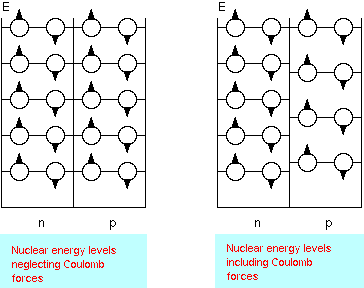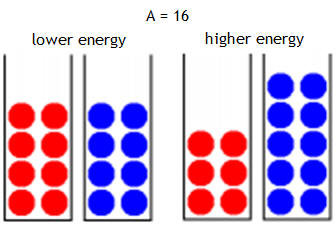 (a) An individual particle model with
nucleons in discrete energy states:
(a) An individual particle model with
nucleons in discrete energy states:The Shell Model (developed by Maria Goeppert-Mayer and Hans Jensen), emphasizes individual particle states in the nucleus. The Nuclear Shell Model is similar to the atomic model where electrons arrange themselves into shells around the nucleus. The Pauli exclusion principle is responsible for a shell structure in atoms and nuclei. The atomic shell structure is due to the quantum nature of electrons and the fact that electrons are fermions. Since protons and neutrons are also fermions, the energy states of the nucleons are filled from the lowest to the highest as nucleons are added to the nucleus. In the shell model the nucleons fill each energy state with nucleons in states with definite angular momentum. There are separate energy levels for protons and neutrons. The simplest representation is to envision neutrons and protons trapped in separate wells. Since protons repel each other via the electric force, their energy levels are slightly higher than the corresponding energy levels of the neutrons in the same nucleus.
The ground state of a nucleus has each of its protons and neutrons in the lowest possible energy level. Excited states of the nucleus are then described as promotions of nucleons to higher energy levels. This model has been very successful in explaining the basic nuclear properties. As is the case with atoms, many nuclear properties (angular momentum, magnetic moment, shape, etc.) are dominated by the last filled or unfilled valence level.
The nuclear shell model explains the existence of "magic numbers". Nuclei with magic neutron number N = 2, 8, 20, 28, 50, 82, 126 or magic proton number Z = 2, 8, 20, 28, 50, 82 have a larger binding energy per nucleon than neighboring nuclei, and when N and Z are both magic the binding energy per nucleon is especially large. This suggests a shell structure, similar to the shell structure in atomic physics, where the noble gases have especially large ionization energies.
